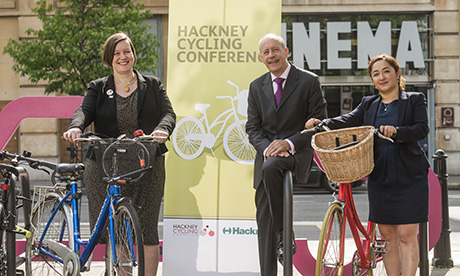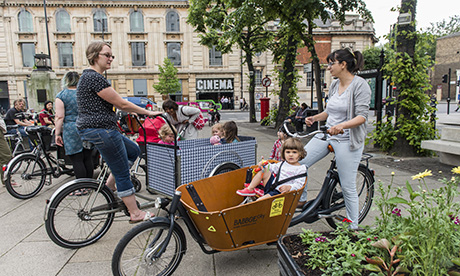Vicious cycle: Improvements for bikes could lead to rent hikes, say experts

(l to r) Meg Hiller MP for Hackney South, Mayor of Hackney Jules Pipe and Councillor Feryal Demirci, Cabinet Member for Neighbourhoods. Photograph: Hackney Council
The changing shape of Hackney’s streets was top of the agenda again this weekend as more than 200 delegates from the cycling world assembled at Hackney Picturehouse for the borough’s fourth annual cycling conference.
Academics, campaigners, transport planners and London councillors heard from 13 speakers at the event – co-hosted by Hackney Council and the London Cycling Campaign – on the theme of ‘the economics of cycling in world-class megacities’.
Among the speakers was London’s Cycling Commissioner Andrew Gilligan, who praised the “unprecedented progress” that cycling in London has made in recent years, but a keynote speech by the President of the League of American Bicyclists Andy Clarke provided the day’s main talking point.
Clarke, a former Hackney resident, presented research conducted in areas of New York City which showed that improved cycling infrastructure raised rent prices by up to 71 per cent.
Many of these improvements to infrastructure, such as segregated cycle routes and pedestrian- and cycle-only streets, have been trialled and employed by Hackney Council. Meg Hillier MP had earlier used her speech to call cycling ‘a part of Hackney’s DNA’, and noted that many new residents are ‘attracted to live in Hackney’ by safe cycling routes and a bike-friendly culture.
Clarke was keen to make clear that the same areas also reported improved community cohesion and economic benefits for local businesses, and pointed to statistics from California where two thirds of local merchants said improved bike lanes had had a positive overall effect on their trade.
But he added: “We [cyclists] are not our own best advocates, and studies show this. We need to improve our image.”
Describing cyclists as ‘at the sharp end of the gentrification debate’, Clarke suggested that his organisation and other cycling advocacy groups ‘need to be aware’ of the link between bike-friendly road improvements and rising rent prices, and should be able to ‘talk about housing issues in a constructive way’.
Councillor Feryal Demirci, Hackney Council’s Cabinet Member for Neighbourhoods, later agreed that the Council had an obligation to take into account any possible negative effects of improvements to Hackney’s streets, saying that while “there is an economic case for investing in cycling, we must ensure it benefits all our residents, old and new”.
The installation of hundreds of cycle lockers, she said, as well as projects like the Cycle Loan Scheme, demonstrates the Council’s commitment to ensuring that “cycling is accessible to all”.
Brenda Puech of the Hackney Cycling Campaign said it was a fact that “people who are walking and cycling generate more trade” and that it was important to offer alternatives to car parking in the borough through improved bike-friendly infrastructure.
The other speakers at the conference focused on issues affecting London more generally, and many Hackney-specific concerns were left unaddressed.
Dr Robin Lovelace, of Leeds University, delivered a data-heavy presentation on a prototype tool designed to identify areas of the UK with potential for growth in cycling, but little was said of the two cycling-related deaths in the borough already this year.
Concerns over major road improvements such as CS1 and the Bloomsbury-Walthamstow Quietway (which will run through Hackney from Middleton Street to Powerscroft Road) were briefly touched upon, although both projects are awaiting the outcome of recent TfL consultations.


71% increase in rents solely due to new bicycling infrastructure in a city which already has one of the highest rents in the world? I’m struggling to believe that. Anyone know what research this refers to?